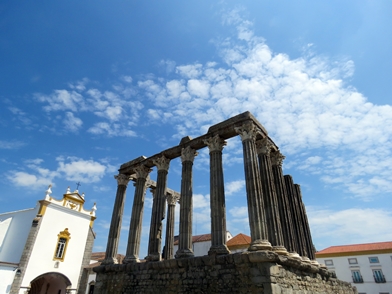Evora
We struggled between a visit to Evora or Tomar on one of the last days in Lisbon. Both are beautiful and UNESCO towns. We took the one closer, Evora. It was a major trading and religious centre under the rule of the Romans. Different tribes ruled the city. Until 1165 Evora was retaken by Geraldo Sem Pavor (Gerald the Fearless). The various rulers left historical monuments / tourist attractions within the city wall.
Rossio de Sao Bras (Igreja de Sao Bras / Ermida de Sao Bras Shrine) welcomed us to Evora and offered farewell to us on a sunny day. It is a 15th century fortified church with cylindrical buttresses covered by roofs with capital. The charming church is not featured in the tourist brochure but you can admire the beauty when approaching the city from the railway station.
 Jardim Publico and Palacio de Dom Manuel / Dom Manuel's Palace await your visit when moving towards the centre of Evora. Apart from being a relaxing venue for the locals, the park's peacocks fight for attention with the striking colours and the historic Dom Manuel's Palace will retain you for quite some time.
Jardim Publico and Palacio de Dom Manuel / Dom Manuel's Palace await your visit when moving towards the centre of Evora. Apart from being a relaxing venue for the locals, the park's peacocks fight for attention with the striking colours and the historic Dom Manuel's Palace will retain you for quite some time.The Praca do Giraldo is named after the hero Giraldo Sem Pavor (Gerald the Fearless), who helped Afonso Henriques expel the Moors from the Alentejo region. In 1484 the Duke of Braganza was beheaded by his brother-in-law, King John II as the duke was in league with the Spanish nobility in an attempt to overthrow the Portuguese throne. In the 16th century, the square was the focal point for the murderous 16th century Spanish Inquisitions.
Nowadays, the square of violence becomes a popular place for tourists to enjoy the relaxing ambience with the presence of many open air cafes and restaurants. The tourist information here provides a lot of information for free. Be sure to grab relevant brochures to maximise the joy of visiting Evora.
At the centre of the square is the ponte Henriquina fountain with eight steams representing the eight streets leading from the Praca do Giraldo. If you are interested in fountains, go southwest of the Se Cathedral to see the Spring of Porta de Moura. It has an iconic marble sphere Renaissance fountain inspired by the Moors.

Diana Roman Temple is one of the most important sightseeing points in Evora and best preserved Roman structure on the Iberian Peninsula. 12 stone Corinthian columns and the connecting architraves remain standing and intact. The temple is situated in the Largo Conde de Vila Flor Square, next to the Se Cathedral and Museum of Evora. It can be seen throughout the day without entrance fee. At the back of the temple is a delightful garden. Colourful flowers and beautiful sculptures assemble beautiful scenes. I like particularly the kissing modern sculpture. The position provides a panoramic view of the city.
Evora Aqueduct (Agua de Prata Aqueduct) is a massive 16th century structure carrying water from the river Riberia do Divor. As Evora flourished in the 16th century, King John III ordered that Evora should have constant supply of water in the mid of Alentejo which had hot summers and mild dry winters. Francisco de Arruda (architect of Torre de Belem) started to build the aqueduct in 1531 and completed the construction in 1537. Water can be easily accessed at the city centre. The aqueduct is still in use. Amazing!

The aqueduct with up to 25 metres mighty arches can be both viewed outside and inside the city walls. For outside, it can be viewed just outside the city walls, by the ring road or where it crosses the R114, 1 km north of Evora.

Inside the city walls, the arches of the aqueduct are much reduced. Underneath are little houses and shops. Best views to the aqueduct are around Rua do Cano, Rua do Salvador and Travessa das Nunes.
The University of Evora was founded in 1959, two decades after the University of Coimbra. It was run by the Society of Jesus for two centuries. In 1759 the Jesuits were expelled from Portugal. The Marquis of Pombal ordered to shut down of all studies in the university. It was reopened only two centuries after (1973). Nowadays, the University of Evora ranks as one of the top universities in Portugal.
A few Euro entrance fee was required for the visit. We didn't like it operating as a money machine and were not well informed on the visit. As we were running out of time, we dropped the visit of the campus but spent a while in the park outside with cute modern sculptures.



















Comments